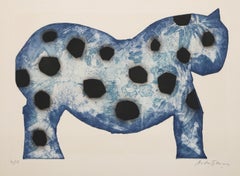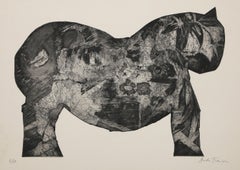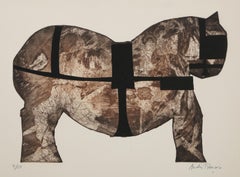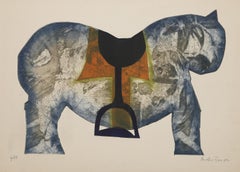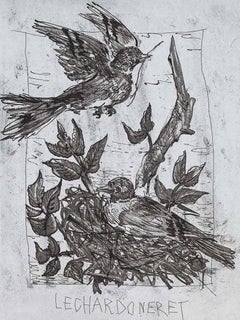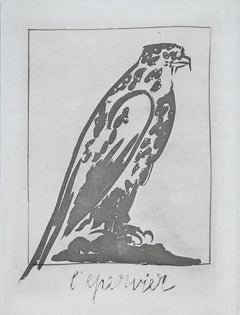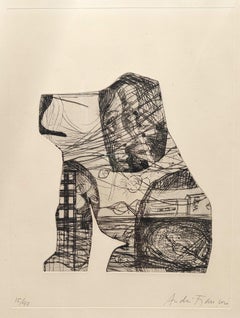André François Animal Prints
French, 1915-2004
Andre Francois (1915–2005)
André François (9 November 1915 – 11 April 2005), born André Farkas, was a Hungarian-born French cartoonist.
He was born in Temesvár, Austria-Hungary (now Timișoara, Romania), He studied at the Academy of Fine Arts in Budapest (1932–33). He moved to Paris in 1934 and entered to the atelier of the famous poster artist Adolphe Cassandre (1935–36). He became a French citizen in 1939.
He worked as a painter, sculptor and graphic designer, but is best remembered for his cartoons, whose subtle humor and wide influence bear comparison to those of Saul Steinberg. François initially worked for French leftist newspapers (Le Nouvel Observateur) and illustrated books by authors such as Jacques Prévert, but gradually reached a larger audience, publishing in leading magazines of the United Kingdom (Punch) and the United States (The New Yorker). He also did a masterpiece cover illustration of the 1965 UK Penguin paperback edition of Lord of the Flies. He became a close friend and collaborator of Ronald Searle. He was member of Alliance Graphique Internationale.
He died in his home in Grisy-les-Plâtres, in the Val-d'Oise département.to
4
Overall Width
to
Overall Height
to
4
7
195
160
111
94
4
4
4
2
2
1
1
1
1
1
1
1
4
4
4
Artist: André François
Cheval Bleu, Modern Etching and Aquatint by Andre Francois
By André François
Located in Long Island City, NY
Andre Francois, Hungarian (1915 - 2005) - Cheval Bleu, Year: circa 1960, Medium: Etching and Aquatint on Arches, signed and numbered in pencil, Edition: 7/50, Image Size: 15.5 x ...
Category
1960s Modern André François Animal Prints
Materials
Aquatint, Etching
Cheval Noir, Modern Etching and Aquatint by Andre Francois
By André François
Located in Long Island City, NY
Andre Francois, Hungarian (1915 - 2005) - Cheval Noir, Year: circa 1960, Medium: Etching and Aquatint on Arches, signed and numbered in pencil, Edition: 6/50, Image Size: 15.5 x ...
Category
1960s Modern André François Animal Prints
Materials
Aquatint, Etching
Cheval, Modern Etching and Aquatint by Andre Francois
By André François
Located in Long Island City, NY
Andre Francois, Hungarian (1915 - 2005) - Cheval, Year: circa 1960, Medium: Etching and Aquatint on Arches, signed and numbered in pencil, Edition: 7/50, Image Size: 15.5 x 22.5 ...
Category
1960s Modern André François Animal Prints
Materials
Aquatint, Etching
Cheval jaune et bleu, Modern Etching and Aquatint by Andre Francois
By André François
Located in Long Island City, NY
Andre Francois, Hungarian (1915 - 2005) - Cheval jaune et bleu, Year: circa 1960, Medium: Etching and Aquatint on Arches, signed and numbered in pencil, Edition: 6/50, Image Size:...
Category
1960s Modern André François Animal Prints
Materials
Aquatint, Etching
Related Items
The Goldfinch, 1942 (Histoire Naturelle - Textes de Buffon, B.348 )
By Pablo Picasso
Located in Greenwich, CT
The Goldfinch is an aquatint and drypoint print on chine from one of the deluxe copies of Picasso's 1942 Histoire Naturelle - Textes de Buffon series. The image size is 11.2 x 8.25 inches, unsigned as issued, and framed in a contemporary silver and gray moulding. One of about 36 prints that exist with Picasso's remarqued title in French, from the edition of 262 (there were 226 portfolios, some with additional sets on varying papers).
Catalogue - Cramer #37
The exceptional etchings from Picasso’s Histoire Naturelle – Textes de Buffon are a masterful combination of sugar-lift aquatint and drypoint, showcasing a full range of gray tonalities. The etchings of animals, birds and insects are considered some of the most beautiful and most unusual examples of Picasso’s graphic work.
Roger Lacourière, Picasso’s master printer, pulled the prints for each etching between 1939-1942. It was Lacourière who taught Picasso the sugar-lift aquatint technique which allowed him to mimic the effect of brushstrokes in these etched images. Picasso first explored the technique in his plates for the Vollard Suite, but it was in the creation of the Buffon images that he fully realized its stunning, painterly potential.
For the edition, 226 portfolios were produced with the first thirty-six counting as deluxe compilations. These rare deluxe sets were on diverse papers (chine, japon or vergé ancien) and each included a complete additional suite showing Picasso’s title remarques along the bottom. As such, the remarqued versions of the prints are quite rare with just thirty-six of each produced for the edition (with the exception of The Wolf which is never remarqued – the image always fills the entire etching plate).
These prints are based on the writings of French naturalist Georges-Louis Leclerc, Comte de Buffon, who extensively documented the natural world in his monumental work Histoire Naturelle. Picasso’s association with the project to illustrate parts of the Buffon came during a tumultuous time in European history – the prelude to, and early years of, World War II. As the continent was ravaged, Picasso lived through the disaster in Paris, which the Germans occupied in 1940. These prints could be seen as a political statement – Picasso channeling his artistic expression into a form of resistance art...
Category
20th Century Modern André François Animal Prints
Materials
Drypoint, Aquatint
$12,850
H 24.125 in W 20.5 in
The Sparrow Hawk, 1942 (Histoire Naturelle - Textes de Buffon, B.342)
By Pablo Picasso
Located in Greenwich, CT
The Sparrow Hawk is an aquatint and drypoint print on chine from one of the deluxe copies of Picasso's 1942 Histoire Naturelle - Textes de Buffon series. The image size is 10.5 x 8 inches, unsigned as issued, and framed in a contemporary silver and gray moulding. One of about 36 prints that exist with Picasso's remarqued title in French, from the edition of 262 (there were 226 portfolios, some with additional sets on varying papers).
Catalogue - Cramer #37
The exceptional etchings from Picasso’s Histoire Naturelle – Textes de Buffon are a masterful combination of sugar-lift aquatint and drypoint, showcasing a full range of gray tonalities. The etchings of animals, birds and insects are considered some of the most beautiful and most unusual examples of Picasso’s graphic work.
Roger Lacourière, Picasso’s master printer, pulled the prints for each etching between 1939-1942. It was Lacourière who taught Picasso the sugar-lift aquatint technique which allowed him to mimic the effect of brushstrokes in these etched images. Picasso first explored the technique in his plates for the Vollard Suite, but it was in the creation of the Buffon images that he fully realized its stunning, painterly potential.
For the edition, 226 portfolios were produced with the first thirty-six counting as deluxe compilations. These rare deluxe sets were on diverse papers (chine, japon or vergé ancien) and each included a complete additional suite showing Picasso’s title remarques along the bottom. As such, the remarqued versions of the prints are quite rare with just thirty-six of each produced for the edition (with the exception of The Wolf which is never remarqued – the image always fills the entire etching plate).
These prints are based on the writings of French naturalist Georges-Louis Leclerc, Comte de Buffon, who extensively documented the natural world in his monumental work Histoire Naturelle. Picasso’s association with the project to illustrate parts of the Buffon came during a tumultuous time in European history – the prelude to, and early years of, World War II. As the continent was ravaged, Picasso lived through the disaster in Paris, which the Germans occupied in 1940. These prints could be seen as a political statement – Picasso channeling his artistic expression into a form of resistance art...
Category
20th Century Modern André François Animal Prints
Materials
Drypoint, Aquatint
$8,850
H 24.125 in W 20.5 in
The White Eagle, 1942 (Histoire Naturelle - Textes de Buffon, B.340)
By Pablo Picasso
Located in Greenwich, CT
The White Eagle is an aquatint and drypoint print on chine from one of the deluxe copies of Picasso's 1942 Histoire Naturelle - Textes de Buffon series. The image size is 10.5 x 8.15 inches, unsigned as issued, and framed in a contemporary silver and gray moulding. One of about 36 prints that exist with Picasso's remarqued title in French, from the edition of 262 (there were 226 portfolios, some with additional sets on varying papers).
Catalogue - Cramer #37
The exceptional etchings from Picasso’s Histoire Naturelle – Textes de Buffon are a masterful combination of sugar-lift aquatint and drypoint, showcasing a full range of gray tonalities. The etchings of animals, birds and insects are considered some of the most beautiful and most unusual examples of Picasso’s graphic work.
Roger Lacourière, Picasso’s master printer, pulled the prints for each etching between 1939-1942. It was Lacourière who taught Picasso the sugar-lift aquatint technique which allowed him to mimic the effect of brushstrokes in these etched images. Picasso first explored the technique in his plates for the Vollard Suite, but it was in the creation of the Buffon images that he fully realized its stunning, painterly potential.
For the edition, 226 portfolios were produced with the first thirty-six counting as deluxe compilations. These rare deluxe sets were on diverse papers (chine, japon or vergé ancien) and each included a complete additional suite showing Picasso’s title remarques along the bottom. As such, the remarqued versions of the prints are quite rare with just thirty-six of each produced for the edition (with the exception of The Wolf which is never remarqued – the image always fills the entire etching plate).
These prints are based on the writings of French naturalist Georges-Louis Leclerc, Comte de Buffon, who extensively documented the natural world in his monumental work Histoire Naturelle. Picasso’s association with the project to illustrate parts of the Buffon came during a tumultuous time in European history – the prelude to, and early years of, World War II. As the continent was ravaged, Picasso lived through the disaster in Paris, which the Germans occupied in 1940. These prints could be seen as a political statement – Picasso channeling his artistic expression into a form of resistance art...
Category
20th Century Modern André François Animal Prints
Materials
Drypoint, Aquatint
$9,850
H 24.125 in W 20.5 in
The Deer, 1942 (Histoire Naturelle - Textes de Buffon, B.336)
By Pablo Picasso
Located in Greenwich, CT
The Deer is an aquatint and drypoint print on chine from one of the deluxe copies of Picasso's 1942 Histoire Naturelle - Textes de Buffon series. The image size is 10.5 x 8.15 inches, unsigned as issued, and framed in a contemporary silver and gray moulding. One of about 36 prints that exist with Picasso's remarqued title in French, from the edition of 262 (there were 226 portfolios, some with additional sets on varying papers).
Catalogue - Cramer #37
The exceptional etchings from Picasso’s Histoire Naturelle – Textes de Buffon are a masterful combination of sugar-lift aquatint and drypoint, showcasing a full range of gray tonalities. The etchings of animals, birds and insects are considered some of the most beautiful and most unusual examples of Picasso’s graphic work.
Roger Lacourière, Picasso’s master printer, pulled the prints for each etching between 1939-1942. It was Lacourière who taught Picasso the sugar-lift aquatint technique which allowed him to mimic the effect of brushstrokes in these etched images. Picasso first explored the technique in his plates for the Vollard Suite, but it was in the creation of the Buffon images that he fully realized its stunning, painterly potential.
For the edition, 226 portfolios were produced with the first thirty-six counting as deluxe compilations. These rare deluxe sets were on diverse papers (chine, japon or vergé ancien) and each included a complete additional suite showing Picasso’s title remarques along the bottom. As such, the remarqued versions of the prints are quite rare with just thirty-six of each produced for the edition (with the exception of The Wolf which is never remarqued – the image always fills the entire etching plate).
These prints are based on the writings of French naturalist Georges-Louis Leclerc, Comte de Buffon, who extensively documented the natural world in his monumental work Histoire Naturelle. Picasso’s association with the project to illustrate parts of the Buffon came during a tumultuous time in European history – the prelude to, and early years of, World War II. As the continent was ravaged, Picasso lived through the disaster in Paris, which the Germans occupied in 1940. These prints could be seen as a political statement – Picasso channeling his artistic expression into a form of resistance art...
Category
20th Century Modern André François Animal Prints
Materials
Drypoint, Aquatint
$12,850
H 24.125 in W 20.5 in
The Monkey, 1942 (Histoire Naturelle - Textes de Buffon, B.339)
By Pablo Picasso
Located in Greenwich, CT
The Monkey is an aquatint and drypoint print on chine from one of the deluxe copies of Picasso's 1942 Histoire Naturelle - Textes de Buffon series. The image size is 10.5 x 7.9 inche...
Category
20th Century Modern André François Animal Prints
Materials
Drypoint, Aquatint
$12,850
H 24.125 in W 20.5 in
The Mother Hen, 1942 (Histoire Naturelle - Textes de Buffon, B.345)
By Pablo Picasso
Located in Greenwich, CT
The Mother Hen is an aquatint and drypoint print on chine from one of the deluxe copies of Picasso's 1942 Histoire Naturelle - Textes de Buffon series. The image size is 10.6 x 8 inc...
Category
20th Century Modern André François Animal Prints
Materials
Drypoint, Aquatint
$12,850
H 24.125 in W 20.5 in
The Donkey, 1942 (Histoire Naturelle - Textes de Buffon, B.329)
By Pablo Picasso
Located in Greenwich, CT
The Donkey is an aquatint and drypoint print on chine from one of the deluxe copies of Picasso's 1942 Histoire Naturelle - Textes de Buffon series. The image size is 10.5 x 8 inches,...
Category
20th Century Modern André François Animal Prints
Materials
Drypoint, Aquatint
$9,850
H 24.125 in W 20.5 in
Bulls and a Frog - Original Etching - Ref. Sorlier #106
By Marc Chagall
Located in Paris, IDF
Marc Chagall
Fables : Bulls and a Frog , 1952
Original etching
Printed signature in the plate
Numbered 61 / 85
On Montval vellum 39 x 28 cm (c. 15 x 11 in)
With COA of the gallery a...
Category
1950s Modern André François Animal Prints
Materials
Etching, Aquatint
The Lobster, 1942 (Histoire Naturelle - Textes de Buffon, B.352)
By Pablo Picasso
Located in Greenwich, CT
The Lobster is an aquatint and drypoint print on chine from one of the deluxe copies of Picasso's 1942 Histoire Naturelle - Textes de Buffon series. The image size is 10.6 x 7.9 inches, unsigned as issued, and framed in a contemporary silver and gray moulding. One of about 36 prints that exist with Picasso's remarqued title in French, from the edition of 262 (there were 226 portfolios, some with additional sets on varying papers).
Catalogue - Cramer #37
The exceptional etchings from Picasso’s Histoire Naturelle – Textes de Buffon are a masterful combination of sugar-lift aquatint and drypoint, showcasing a full range of gray tonalities. The etchings of animals, birds and insects are considered some of the most beautiful and most unusual examples of Picasso’s graphic work.
Roger Lacourière, Picasso’s master printer, pulled the prints for each etching between 1939-1942. It was Lacourière who taught Picasso the sugar-lift aquatint technique which allowed him to mimic the effect of brushstrokes in these etched images. Picasso first explored the technique in his plates for the Vollard Suite, but it was in the creation of the Buffon images that he fully realized its stunning, painterly potential.
For the edition, 226 portfolios were produced with the first thirty-six counting as deluxe compilations. These rare deluxe sets were on diverse papers (chine, japon or vergé ancien) and each included a complete additional suite showing Picasso’s title remarques along the bottom. As such, the remarqued versions of the prints are quite rare with just thirty-six of each produced for the edition (with the exception of The Wolf which is never remarqued – the image always fills the entire etching plate).
These prints are based on the writings of French naturalist Georges-Louis Leclerc, Comte de Buffon, who extensively documented the natural world in his monumental work Histoire Naturelle. Picasso’s association with the project to illustrate parts of the Buffon came during a tumultuous time in European history – the prelude to, and early years of, World War II. As the continent was ravaged, Picasso lived through the disaster in Paris, which the Germans occupied in 1940. These prints could be seen as a political statement – Picasso channeling his artistic expression into a form of resistance art...
Category
20th Century Modern André François Animal Prints
Materials
Drypoint, Aquatint
$12,850
H 24.125 in W 20.5 in
Wolfman
By Donald Saff
Located in Middletown, NY
Etching with aquatint on white wove paper with a deckle edge, 23 1/2 x 17 1/2 inches (598 x 317 mm); sheet 30 x 22 1/2 inches (762 x 571 mm), full margins. Signed and numbered 4/10 i...
Category
Late 20th Century American Modern André François Animal Prints
Materials
Handmade Paper, Etching, Aquatint
The Pigeon, 1942 (Histoire Naturelle - Textes de Buffon, B.347)
By Pablo Picasso
Located in Greenwich, CT
The Pigeon is an aquatint and drypoint print on chine from one of the deluxe copies of Picasso's 1942 Histoire Naturelle - Textes de Buffon series. The image size is 10.75x 8 inches, unsigned as issued, and framed in a contemporary silver and gray moulding. One of about 36 prints that exist with Picasso's remarqued title in French, from the edition of 262 (there were 226 portfolios, some with additional sets on varying papers).
Catalogue - Cramer #37
The exceptional etchings from Picasso’s Histoire Naturelle – Textes de Buffon are a masterful combination of sugar-lift aquatint and drypoint, showcasing a full range of gray tonalities. The etchings of animals, birds and insects are considered some of the most beautiful and most unusual examples of Picasso’s graphic work.
Roger Lacourière, Picasso’s master printer, pulled the prints for each etching between 1939-1942. It was Lacourière who taught Picasso the sugar-lift aquatint technique which allowed him to mimic the effect of brushstrokes in these etched images. Picasso first explored the technique in his plates for the Vollard Suite, but it was in the creation of the Buffon images that he fully realized its stunning, painterly potential.
For the edition, 226 portfolios were produced with the first thirty-six counting as deluxe compilations. These rare deluxe sets were on diverse papers (chine, japon or vergé ancien) and each included a complete additional suite showing Picasso’s title remarques along the bottom. As such, the remarqued versions of the prints are quite rare with just thirty-six of each produced for the edition (with the exception of The Wolf which is never remarqued – the image always fills the entire etching plate).
These prints are based on the writings of French naturalist Georges-Louis Leclerc, Comte de Buffon, who extensively documented the natural world in his monumental work Histoire Naturelle. Picasso’s association with the project to illustrate parts of the Buffon came during a tumultuous time in European history – the prelude to, and early years of, World War II. As the continent was ravaged, Picasso lived through the disaster in Paris, which the Germans occupied in 1940. These prints could be seen as a political statement – Picasso channeling his artistic expression into a form of resistance art...
Category
20th Century Modern André François Animal Prints
Materials
Drypoint, Aquatint
$14,850
H 24.125 in W 20.5 in
The Vulture. 1942 (Histoire Naturelle - Textes de Buffon, B.341)
By Pablo Picasso
Located in Greenwich, CT
The Vulture is an aquatint and drypoint print on chine from one of the deluxe copies of Picasso's 1942 Histoire Naturelle - Textes de Buffon series. The image size is 10.6 x 8 inches, unsigned as issued, and framed in a contemporary silver and gray moulding. One of about 36 prints that exist with Picasso's remarqued title in French, from the edition of 262 (there were 226 portfolios, some with additional sets on varying papers).
Catalogue - Cramer #37
The exceptional etchings from Picasso’s Histoire Naturelle – Textes de Buffon are a masterful combination of sugar-lift aquatint and drypoint, showcasing a full range of gray tonalities. The etchings of animals, birds and insects are considered some of the most beautiful and most unusual examples of Picasso’s graphic work.
Roger Lacourière, Picasso’s master printer, pulled the prints for each etching between 1939-1942. It was Lacourière who taught Picasso the sugar-lift aquatint technique which allowed him to mimic the effect of brushstrokes in these etched images. Picasso first explored the technique in his plates for the Vollard Suite, but it was in the creation of the Buffon images that he fully realized its stunning, painterly potential.
For the edition, 226 portfolios were produced with the first thirty-six counting as deluxe compilations. These rare deluxe sets were on diverse papers (chine, japon or vergé ancien) and each included a complete additional suite showing Picasso’s title remarques along the bottom. As such, the remarqued versions of the prints are quite rare with just thirty-six of each produced for the edition (with the exception of The Wolf which is never remarqued – the image always fills the entire etching plate).
These prints are based on the writings of French naturalist Georges-Louis Leclerc, Comte de Buffon, who extensively documented the natural world in his monumental work Histoire Naturelle. Picasso’s association with the project to illustrate parts of the Buffon came during a tumultuous time in European history – the prelude to, and early years of, World War II. As the continent was ravaged, Picasso lived through the disaster in Paris, which the Germans occupied in 1940. These prints could be seen as a political statement – Picasso channeling his artistic expression into a form of resistance art...
Category
20th Century Modern André François Animal Prints
Materials
Drypoint, Aquatint
$8,850
H 24.125 in W 20.5 in
Previously Available Items
Dog. 1975. Paper, etching 15/40. 38x28 cm
By André François
Located in Riga, LV
Dog. 1975. Paper, etching 15/40. 38x28 cm
This etching depicts a dog in profile pose. The body of the animal is filled with different figures. This work is affected by surrealism which is intended to revolutionize human experience. It balances a rational vision of life with one that asserts the power of the unconscious and dreams. Artist finds magic and strange beauty in the unexpected and the uncanny, the disregarded and the unconventional.
Information about artist:
Andre Francois...
Category
1970s Realist André François Animal Prints
Materials
Paper, Etching
André François animal prints for sale on 1stDibs.
Find a wide variety of authentic André François animal prints available for sale on 1stDibs. You can also browse by medium to find art by André François in aquatint, etching and more. Much of the original work by this artist or collective was created during the 1960s and is mostly associated with the modern style. Not every interior allows for large André François animal prints, so small editions measuring 30 inches across are available. Customers who are interested in this artist might also find the work of Mordecai Moreh, Fabrizio Clerici, and Alexander Calder. André François animal prints prices can differ depending upon medium, time period and other attributes. On 1stDibs, the price for these items starts at $450 and tops out at $450, while the average work can sell for $450.
